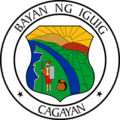Iguig | |
|---|---|
| Municipality of Iguig | |
 St. James the Apostle Parish in Calvary Hills | |
| Nickname: Pottery Center of Cagayan | |
 Map of Cagayan with Iguig highlighted | |
 Interactive map of Iguig | |
Location within the Philippines | |
| Coordinates: 17°45′06″N121°44′11″E / 17.7517°N 121.7364°E | |
| Country | Philippines |
| Region | Cagayan Valley |
| Province | Cagayan |
| District | 3rd district |
| Founded | December 28, 1607 |
| Barangays | 23 (see Barangays) |
| Government | |
| • Type | Sangguniang Bayan |
| • Mayor | Ferdinand B. Trinidad |
| • Vice Mayor | Juditas L. Trinidad |
| • Representative | Joseph L. Lara |
| • Electorate | 18,868 voters (2025) |
| Area | |
• Total | 108.10 km2 (41.74 sq mi) |
| Elevation | 34 m (112 ft) |
| Highest elevation | 143 m (469 ft) |
| Lowest elevation | 8 m (26 ft) |
| Population (2024 census) [3] | |
• Total | 31,342 |
| • Density | 289.94/km2 (750.93/sq mi) |
| • Households | 7,015 |
| Economy | |
| • Income class | 4th municipal income class |
| • Poverty incidence | 10.76 |
| • Revenue | ₱ 191.5 million (2022) |
| • Assets | ₱ 545.3 million (2022) |
| • Expenditure | ₱ 174.6 million (2022) |
| • Liabilities | ₱ 239.1 million (2022) |
| Service provider | |
| • Electricity | Cagayan 1 Electric Cooperative (CAGELCO 1) |
| Time zone | UTC+8 (PST) |
| ZIP code | 3504 |
| PSGC | |
| IDD : area code | +63 (0)78 |
| Native languages | Ibanag Ilocano Tagalog |
| Website | www |
Iguig, officially the Municipality of Iguig (Ibanag : Ili nat Iguig; Ilocano : Ili ti Iguig; Tagalog : Bayan ng Iguig), is a municipality in the province of Cagayan, Philippines. According to the 2024 census, it has a population of 31,342 people. [5]


